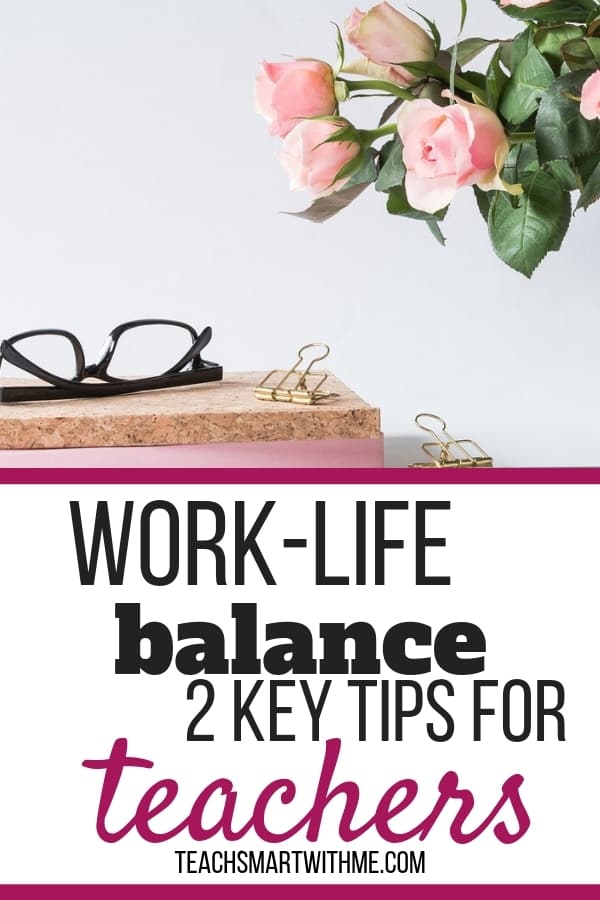Do you ever ask yourself how to achieve healthy work-life balance for teachers? Read to find two important tips to implement boundaries and get the balance you desire.
Updated: 5th February 2020.

For many teachers, it’s very difficult to have the work-life balance that you crave.
Lately, I’ve been feeling very overwhelmed with the workload of my teacher’s life; with all the planning and marking that I was taking home every night and on weekends.
I felt that work was taking over my life!!
Do you ever feel like that too? Well of course you do…. don’t all teachers??
Get your FREE checklist to work smarter not harder here:
My story to find a healthy work-life balance as a teacher
On my search for work-life balance, I happen to hear a wellness coach that was invited to speak at one of our staff meetings.
Her talk was on balance… Good timing!
But I was feeling a bit cynical sitting listening to her speak. Because we all know that to do our jobs effectively as professionals, it takes many hours of work every day.
All I was thinking was, ‘Is it even possible to get work-life balance as a teacher?’
At this particular point in my teaching career, I had become very resentful of the long hours and I felt quite negative with it all too…. as you do.
The speaker’s information started to resonate with me.
She described teachers as salaried employees.
I’d never really thought of myself as being salaried.
My only understanding of this was when my husband was on salary when he worked for an oil rig years before. He hated it because there was no defined start or finish time, and he always said that they got their ‘pound of flesh’ out of him.
So, as an employee of an Education Department, salaried means much the same. You’re basically expected to work for as long as it takes to get the job done.
Well, this was a bitter pill to swallow!
But, she did explain that as teachers, we could see this as a positive and consider ourselves lucky because of the flexibility in our working life.
Ok. Interesting. I hadn’t looked at it like that before.
But, it was the next thing that she said that really stuck with me.
She said that as a teacher you need to set time boundaries for your working
Related Article: How to Set Boundaries as a Teacher & Why It’s So Important
Wow! This news came as a light-bulb moment for me!

Don’t forget to get your FREE Working Smarter checklist here:
But as teachers how can you set limits on your working day?
This is where I realised that I needed to become my own advocate and start setting some boundaries for myself.
To explain how this can be achieved, here are some basics for setting boundaries for work and home, which I’m now using to develop better work-life balance for myself.
Related Article: Secrets of Work-Life Balance for Teachers
Healthy work-life balance for teachers
Here’s how I stopped teaching take over my life:
Tip 1: Set working hours
When setting your working hours you really must think about what your own personal limits are and what you’re prepared to do in your teaching job.
Let’s explore this a bit more.
As teachers, whether we realise or not, we are the ones in charge of how long we work and where we work, outside of the 9:00 to 3:00 pm requirement.
Think about this for a bit.
How many hours are you prepared to work as a teacher? Is it 50 hours per week or 60 hours? or more/less?
Is it all at school or are you prepared to work at home too?
You need to know the answers to these questions.
If you haven’t even got a clue how many hours you work, you NEED to find out.
Track your working hours
Start by keeping track of your hours and tally them all up for a week.
Once you know these stats, if you’re not happy and want to make changes, you now have at least a starting point.
You can’t change what you don’t know.
Plus, it will help make all the invisible hours that you do in your job more visible, so you are aware of it. This might be an eye-opening activity!
Once you know how many hours you work each week, then think, ‘Is this the number of hours I want to be working?’
If you’re not happy with how much time you spend at your teaching job, set a goal for working hours and also set a non-negotiable start and finish time to help you limit how much you work.
Make it suit you and your family. For example, if you work 7:30 am to 4:00 pm every day except Fridays, with a 30-minute break for lunch, that’s a 10 hour day!! or a 50 hour week. (not including weekend work).
When you know your start and finish time, you’ll find that you’ll be much more productively while on the job because you now have a deadline.
Stop the teacher guilt
After your finish time, don’t take your teacher bag with you and then forget about school. There’s no need for any GUILT!!
You’ve worked hard and you deserve to rest. This is how you will get greater work-life balance.
N.B. If you have children that you need to be collected and taken home, limit the hours of work you will when you get home. For example “I will not work after 8:00 pm at night.”
Related Article: How to Set Boundaries as a Teacher and Why it’s so Important
TIP 2: Set clear boundaries for working at home
Time limits are important for when you work at home, but another very important boundary to set for working at home is to make a designated workspace in your house, away from where you and your family relax and connect.
Related Article: How to Set Boundaries for Teachers and Why It’s So Important
Why do you need a defined workspace at home?
If you’re asking this question you really need this boundary!
Anyway, by having an office space in your house or just one end of the dining table, this defined workspace allows your mind to differentiate when you are working and when you are not.
While you are in this working area, your mind and your family will know that you are still on the job.
Later, when you leave this space, your brain will understand that work is finished and then you can begin to relax and enjoy your home life.
An example to explain:
The Wellness coach gave us an example of a non-negotiable boundary for working at for home. She said not to do school work in your bed.
She said that if you complete marking or any other school activity in this private space, there won’t be a clear delineation between school and home.
What happens is, your body and brain become confused – your mind can’t decide what part of your house is for rest and what is for work. This creates difficulties for your brain to be able to switch off from work.
So, don’t work all over the house or in your bed. Set up a defined work-space in your house so that clear boundaries are in place and you can develop a better work-life balance that your body craves.
** The magic in these suggestions and by setting limit and boundaries between home and school, is that when you are home or leave your workspace, you will be able to fully rest and feel that you have finished work.

My work-life balance successes
I now follow these two key pieces of advice for my own work-life balance.
What works well for me is, if I stay at work until 5:00 pm or 5:30 pm, which is a long day, but, when it reaches my time cutoff, I know that I have put in my best efforts and I’ve done what I could to finish my prioritised tasks for the day.
Then, when I go home, I can fully wind down and put work out of my head, without taking that darn teacher bag home!
I now also refuse to work in bed, even though it’s comfortable.
I also avoid working while sitting at the lounge or at the kitchen table…Well, this still remains a goal of mine. 🙂 But I have implemented a defined working area in my home.
I’m feeling like teaching isn’t taking over my life as much as it felt before, which is a huge improvement.
I still know there are hectic times in my job when it’s nearly impossible not to work at home, but I’m really trying really hard to limit how much I do outside of school hours.
While life is still very busy, I’m training myself with my work-life balance and setting clearer boundaries between work and home.
This, in turn, has reduced the feelings of guilt that I was having before when I wasn’t doing school work.
I now can also fully rest when I’m at home and forget about work.
It’s my hope that these tips for setting boundaries have been useful to you and gives you some ideas to work towards better work-life balance as a busy teacher.
Related Articles
PIN IT FOR LATER!


Remember you are worth it!
Michelle X


Leave a Reply